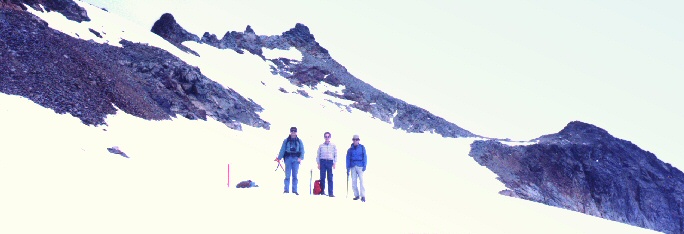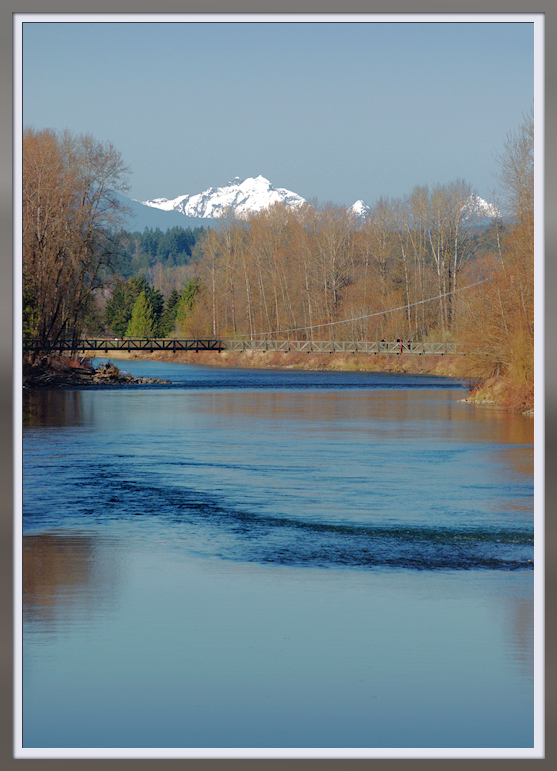Posts Tagged ‘cascade mountains’
A lifetime of Pacific Northwest Photography
Mount Si
On the eastern end of the most heavily populated county of Washington State, prominent Mount Si (pronounced Mount “Sigh”) rises roughly 4,000 feet off the valley floor of the Snoqualmie River. Named for Josiah “Uncle Si” Merritt, an early settler, Mount Si marks the beginning of the Cascade Range as seen from Interstate 90 as you travel east into the range. Its prominence evokes your attention. (Click images for larger views)
Mount Si may have been the visual source of inspiration for the name “Twin Peaks”, a 30-episode television show that aired in the early 1990’s. Scenes from Twin Peaks and the expansive movie version, “Twin Peaks – Fire Walk With Me,” were filmed in a couple of small towns nearby Mount Si. Misty Snoqualmie Falls, the lodge above the falls, railroad cars at Snoqualmie, and a restaurant located in North Bend served as props in both shows. Indoor scenes were typically filmed inside a studio.
It is a fascinating mountain. What strikes most people about Mount Si is its abrupt rocky face. I especially like photographing it in the late in the afternoon when it is fully illuminated by sunlight. This mountain has many different looks. Mount Si takes on different appearances depending upon angle of sunlight, time of year, and weather. I began photographing Mount Si this only in the past three years, even though I have lived close by for more than 20 years, a testament to the abundance of subject matter the Pacific West Coast of America has to offer.
Mount Si’s own website
Mt. Si on Wikipedia
Mount Si Golf Course
Twin Peaks poster (fan compiled – copyrighted)
Twin Peaks Fest
More mountains
Volcanic Glacier Peak
Glacier Peak
Glacier Peak is a primary volcano that is positioned deep in the central Cascades of Washington about 70 miles from Seattle. It is the highest Cascade peak north of Mount Rainier and south of Mount Baker. Since Glacier Peak is not as visible from the larger nearby metropolitan areas as the other major volcanoes (i.e., Baker, Rainier, St. Helens), it is less publicly known. However, Glacier Peak has been more violent since after the time of the last great ice age than Mount St. Helens.
Violent Past
Glacier Peak was formed around a million years ago during the Pleistocene period. Then, for a period of a few hundred years around 13,000 years ago, Glacier Peak violently erupted approximately nine times. The largest of these eruptions ejected more than five times as much rock and ash as the May 18, 1980, eruption of Mount St. Helens. Deposits from these eruptions left more than a foot of rock and ash near Chelan, Washington, and as much as an inch of ash in western Montana. In contrast, by the time Mount St. Helen’s ash completely settled after the May 18, 1980 eruption, only a light dusting made it as far as Montana.
Glacier Peak Lahars
Westward lahars (see Lahar post) off Glacier Peak flowed as far as down the North Fork Stillaguamish and Skagit Rivers into the sea. Near Arlington, seven feet of sediment are attributable to Glacier Peak eruptions, though these have been overshadowed by the greater lahars from Mount Baker.
Information source: U.S. Geological Survey Fact Sheet 058-00 Online Version 1.0
What is the Pacific Northwest? And where is it?
The Pacific Northwest, geographically referred to as Cascadia, is the northwest region of North America, and is bound by the Pacific Ocean. It encompasses all of Washington, Oregon States and Northern California, British Columbia Canada, and Alaska. It is an area of vast beauty. Here you will find multiple climates and topography, from the highest mountains on the continent, to many thousands of miles of coastline, and globally rare inland seas.
 |
Washington – Grandeur of the North Cascades
Sahale Mountain, one of the most popular climbs in the North Cascades, is located near Marblemount. Compared to some of it’s close neighbors, to climb Sahale is relatively simple and straight-forward. An elevation gain of 6200 feet and outstanding views of the heart of the North Cascades are sure to satisfy. Climbing Sahale is very similar to the alps in terms of weather and the quality of alpine climbing. Source: Summit Post
This was a 12 hour climb for us. Much of it was on glacier, but the most severe effort was on loose shale rock and a couple places of near-vertical rock. We chose the east approach which turned out to be more difficult than the more popular west approach. Coming back down, I asked the climber beneath me to plant my foot in a foothold because I could not see what was below the rock face I was on. I could see the valley perhaps 3,000 feet below to the east. This was a real adventure for me never having any formal rock climbing experience beforehand. There were rope-climbers around us.

Sahale Peak Climbers (me on left)
Mount Si – July 4th 2009

On the eastern end of the most heavily-populated county of Washington State, prominent Mount Si (pr. “Sigh”) rises roughly 4,000 feet off the valley floor of the Snoqualmie River. Named for Josiah “Uncle Si” Merritt, an early settler, Mount Si marks the beginning of the Cascade Range as seen from Interstate 90 as you travel east into the range. Its prominence evokes your attention.
Mount Si may have been the visual source of inspiration for the name Twin Peaks, a 30-episode television show that aired in the early 1990’s. Scenes from Twin Peaks and the expansive movie version, “Twin Peaks – Fire Walk With Me,” were filmed in a couple of small towns nearby Mount Si. Misty Snoqualmie Falls, the lodge above the falls, railroad cars at Snoqualmie, and a restaurant located in North Bend served as props in both shows. Indoor scenes were typically filmed inside a studio elsewhere.
It is a fascinating mountain. What strikes most people about Mount Si is its abrupt rocky face. I especially like photographing it in the late in the afternoon when it is fully illuminated by sunlight. This mountain has many different looks. Mount Si takes on different appearances depending upon angle of sunlight, time of year, and weather. I only began photographing Mount Si this past year or so, even though I have lived close by for more than 20 years, a testament to the abundance of subject matter the Pacific West Coast of America has to offer. Mount Si on Wikipedia. See more mountains!








